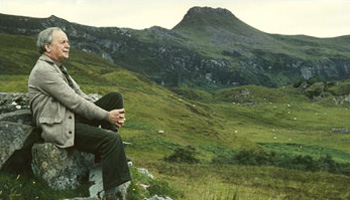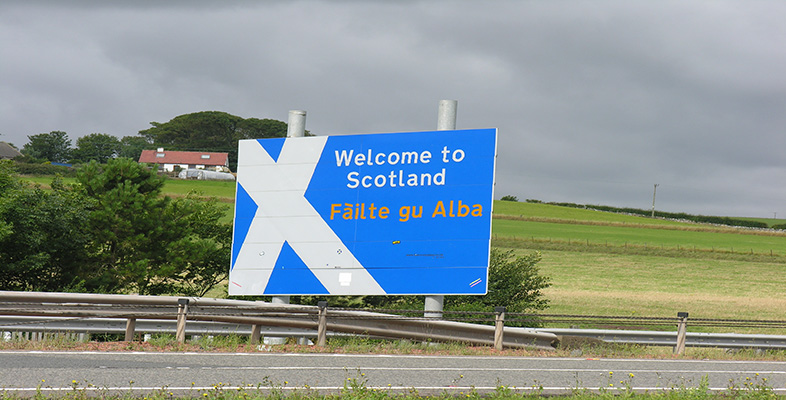6.4.1 Poetry
The Gaelic poetry of the 17th century is interesting more for the light it throws on the clan-based society of the time than for its literary merit. Comprising mostly praise of chiefs, it is an example of verse used for propaganda purposes and of poets as the spin-doctors of their day.
The 18th century saw the Highlands opening out to the outside world, as education spread and the travel became easier (especially after the failure of the Jacobite Rising of 1745/6). A recognisably modern form of society was beginning to emerge and this is reflected in the poetry of the time, which is marked by new styles of writing and a wider range of subjects, including the nature poetry of Donnchadh Bàn (Duncan Macintyre), the love songs of Uilleam Ros (William Ross), and the satire of Sutherland poet Rob Donn (Robert Mackay).
Rannan às an eadar-theangachadh Bheurla aig Iain Mac a’ Ghobhainn air ‘Moladh Beinn Dòbhrainn’ le Donnchadh Bàn Mac an t-Saoir. Greadhainn bu gheal cèir, Faghaid air an dèidh – ’S laghach leam an sreud A bha sròineiseach. ….. ’S aigeannach fear eutrom Gun mhòrchuis Thèid fasanta na èideadh Neo-spòrsail. Tha mhantal uime fhèin, Caithtiche nach trèig – Bratach dhearg mar chèir Bhiodh mar chòmhdach air. | This image of the deer as the nobility of the glens is from Iain Crichton Smith’s free translation of Donnchadh Bàn’s tour-de-force, ‘Praise of Ben Dòrain’. Herds with white rumps race - hunters in the chase. O I love the grace of these noble ones. ….. Spirited and delicate and shy, in fashionable coat he goes by in mantle well arrayed, suit that will not fade, dress of waxen-red that he's wearing now. |
The 19th century and the first half of the 20th century – an era of much poverty and social upheaval in the Highlands – produced little of merit in Gaelic poetry, although some of the subjects and styles of the great 18th century poets has survived, through this period and up to the present day, in the work of the local poets known as ‘village bards’ (some of whom are much more than that).
Then, out of the blue, a slim volume was published in 1943 which brought Gaelic poetry at one fell swoop into line with the best writing of its time in English and other languages. Sorley MacLean managed to bring together in Dàin do Eimhir the best of the Gaelic tradition and of world literature and he did so with an infectious enthusiasm that has inspired generations of Gaelic writers up to the present day.
MacLean the poet was torn between the demands of love and family on the one hand, and his sense of duty and political ideals on the other, of which socialism and the Spanish Civil War are the keynotes. He interweaved this inner conflict with other themes to produce, in Dàin do Eimhir, a multi-textured sequence of poems which is highly-wrought both artistically and emotionally.

Click on the audio clips below to hear a interview with Sorley MacLean.
Transcript: Interview with Sorley MacLean – Part 1
Transcript: Interview with Sorley MacLean – Part 2
Transcript: Interview with Sorley MacLean – Part 3
Transcript: Interview with Sorley MacLean – Part 4
Among the other notable Gaelic poets of the late 20th and early 21st centuries are Derick Thomson, Iain Crichton Smith, Aonghas Macneacail, Catriona Montgomery, Meg Bateman, and Myles Campbell.
Thomson, in particular, has written and published poetry over six decades, changing his style and preoccupations over time but retaining the qualities that make him an outstanding poet, namely:
- a subtle intellect, emotional depth and the ability to seamlessly blend the two
- free verse which has the musicality of the traditional song metres – but more flexibility
- robust, yet precise, use of language
- a wry wit and a sharp sense of irony.
The following poem is a typical example of that sense of irony:
Alba v. Argentina, 2/6/79 mìos às dèidh Taghadh na Pàrlamaid, 3/5/79 Glaschu a’ cur thairis le gràdh dùthcha, leòmhainn bheucach air Sràid an Dòchais, an Central mùchte le breacan, cop air Tartan bho mhoch gu dubh, is mùn nam fineachan air a’ bhlàr; iolach-catha a’ bàthadh bùrail nam busaichean – Sco-o-t-land, Sco-o-t-land – Alba chadalach, mìos ro fhadalach. | Scotland v. Argentina, 2/6/79 a month after the General Election, 3/5/79 Glasgow erupting with patriotism, growling lions on Hope Street, the Central choked with Tartan, foaming from dawn to dusk, and clansmen’s piss on the battlefield; the battle-cry drowning the buses’ drone – Sco-o-t-land, Sco-o-t-land – sleepy Scotland, a month late. |
An example of the work of the younger poets, Aonghas Macneacail’s ‘Marilyn Monroe’, can be seen in Section 4. Written in Gaelic and English, it has a more modern feel than Thomson’s work but is equally skillful and insightful.
